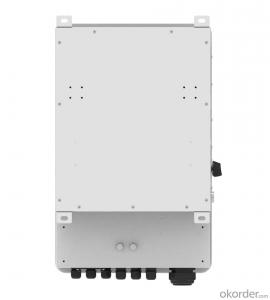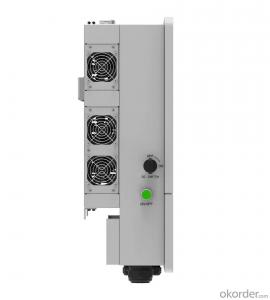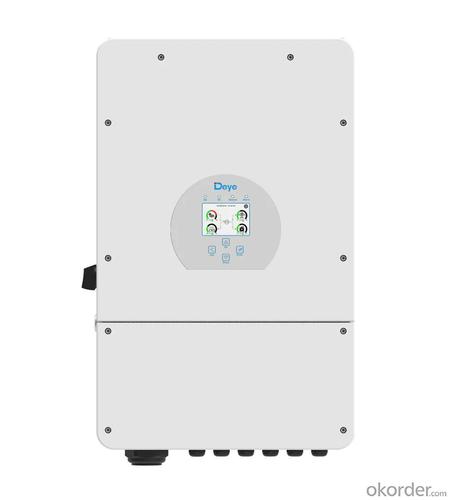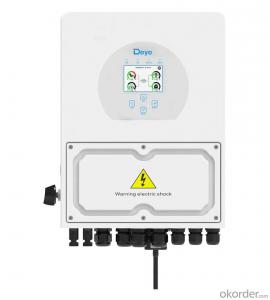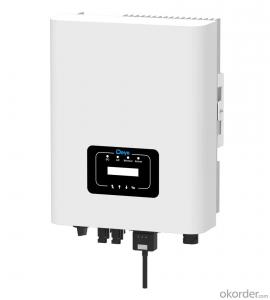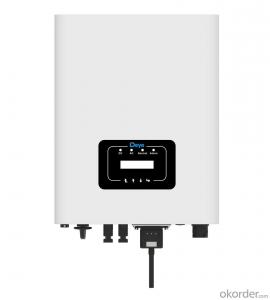Generac Solar Inverter - Sun-12/14/16k-Sg01Lp1 | 12-16kW | Single Phase | 2 MPPT | Hybrid Inverter
- Loading Port:
- Ningbo
- Payment Terms:
- TT OR LC
- Min Order Qty:
- 100 pc
- Supply Capability:
- 5000 pc/month
OKorder Service Pledge
OKorder Financial Service
You Might Also Like
Specification
| Technical Data | ||||||||
| Model | SUN-5K -SG01LP1-US | SUN-6K -SG01LP1-US | SUN-7.6K -SG01LP1-US/EU | SUN-8K -SG01LP1-US/EU | ||||
| Battery Input Data | ||||||||
| Battery Type | Lead-acid or Li-lon | |||||||
| Battery Voltage Range (V) | 40~60 | |||||||
| Max. Charging Current (A) | 120 | 135 | 190 | 190 | ||||
| Max. Discharging Current (A) | 120 | 135 | 190 | 190 | ||||
| External Temperature Sensor | Yes | |||||||
| Charging Curve | 3 Stages / Equalization | |||||||
| Charging Strategy for Li-Ion Battery | Self-adaption to BMS | |||||||
| PV String Input Data | ||||||||
| Max. DC Input Power (W) | 6500 | 7800 | 9880 | 10400 | ||||
| Rated PV Input Voltage (V) | 370 (125~500) | |||||||
| Start-up Voltage (V) | 125 | |||||||
| MPPT Voltage Range (V) | 150-425 | |||||||
| Full Load DC Voltage Range (V) | 300-425 | 200-425 | ||||||
| PV Input Current (A) | 13+13 | 26+13 | 26+26 | |||||
| Max. PV ISC (A) | 17+17 | 34+17 | 34+34 | |||||
| Number of MPPT / Strings per MPPT | 2/1+1 | 2/2+1 | 2/2+2 | |||||
| AC Output Data | ||||||||
| Rated AC Output and UPS Power (W) | 5000 | 6000 | 7600 | 8000 | ||||
| Max. AC Output Power (W) | 5500 | 6600 | 8360 | 8800 | ||||
| AC Output Rated Current (A) | 20.8/24 | 25/28.8 | 31.7/36.5 | 34.5 | 33.3/38.5 | 36.4 | ||
| Max. AC Current (A) | 22.9/26.4 | 27.5/31.7 | 34.8/40.2 | 38 | 36.7/42.3 | 40 | ||
| Max. Continuous AC Passthrough (A) | 40 | 50 | ||||||
| Peak Power (off grid) | 2 time of rated power, 10 S | |||||||
| Power Factor | 0.8 leading to 0.8 lagging | |||||||
| Output Frequency and Voltage | 50 / 60Hz; L1/L2/N(PE) 120/240Vac (split phase), 208Vac (2/3 phase), L/N/PE 220/230Vac (single phase) | |||||||
| Grid Type | Split phase; 2/3 phase; Single Phase | |||||||
| DC injection current (mA) | THD<3% (Linear load<1.5%) | |||||||
| Efficiency | ||||||||
| Max. Efficiency | 97.60% | |||||||
| Euro Efficiency | 97.00% | |||||||
| MPPT Efficiency | 99.90% | |||||||
| Protection | ||||||||
| Integrated | PV Input Lightning Protection, Anti-islanding Protection, PV String Input Reverse Polarity Protection, Insulation Resistor Detection, Residual Current Monitoring Unit, Output Over Current Protection, Output Shorted Protection, Surge protection | |||||||
| Output Over Voltage Protection | DC Type II/AC Type III | |||||||
| Certifications and Standards | ||||||||
| Grid Regulation | CEI 0-21, VDE-AR-N 4105, NRS 097, IEC 62116, IEC 61727, G99, G98, VDE 0126-1-1, RD 1699, C10-11 | |||||||
| Safety EMC / Standard | IEC/EN 61000-6-1/2/3/4, IEC/EN 62109-1, IEC/EN 62109-2 | |||||||
| General Data | ||||||||
| Operating Temperature Range (℃) | -45~60℃, >45℃ derating | |||||||
| Cooling | Smart cooling | |||||||
| Noise (dB) | <30 dB | |||||||
| Communication with BMS | RS485; CAN | |||||||
| Weight (kg) | 32 | |||||||
| Size (mm) | 420W×670H×233D | |||||||
| Protection Degree | IP65 | |||||||
| Installation Style | Wall-mounted | |||||||
| Warranty | 5 years | |||||||
Colorful touch LCD, IP65 protection degree
6 time periods for battery charging/discharging
Max. charging/discharging current of 190A
Max.16pcs parallel
DC couple and AC couple to retrofit existing solar system
Support storing energy from diesel generator
Max. battery charge efficiency of 95.4%
Unique Smart Load application and Grid peak shaving function
4ms fast transfer from on-grid to off-grid mode, ensuing the traditional fixed frequency air conditioner works well
Certified by UL, CE, IEC, VDE, NRS, VFR, AS4777.2, CEI and INMETRO etc.
The series, SUN-5/6K-SG01LP1-US SUN-7.6/8K-SG01LP1-US/EU, is a single-phase low voltage (48V) hybrid inverter that enables enhanced energy independence and maximizes self-consumption through export limit feature and “time of use” function. With the frequency droop control algorithm, this series product supports single phase and three phase parallel application, and the Max. parallel units is up to 16pcs.
- Q: Can a solar inverter be connected to the grid?
- Yes, a solar inverter can be connected to the grid. In fact, grid-connected solar inverters are designed to convert the direct current (DC) generated by solar panels into alternating current (AC) that can be fed back into the electrical grid. This allows excess electricity produced by the solar panels to be distributed and used by other consumers, and in some cases, even earn credits or financial compensation through net metering.
- Q: What is the role of a solar inverter in maximizing solar panel output?
- The role of a solar inverter in maximizing solar panel output is to convert the direct current (DC) generated by the solar panels into alternating current (AC) which can be used to power electrical devices in homes or businesses. The inverter ensures that the AC output is synchronized with the grid's frequency and voltage, allowing for efficient and effective utilization of solar energy. Additionally, the inverter also helps in monitoring and optimizing the performance of the solar panels, ensuring that they operate at their maximum efficiency and produce the highest possible output.
- Q: How do you choose the right size of solar inverter for a solar power system?
- To choose the right size of solar inverter for a solar power system, you need to consider the total capacity of your solar panels and the maximum power output they can generate. The solar inverter's capacity should be equal to or slightly higher than the maximum power output of your solar panels to ensure optimal performance and efficiency. Additionally, you should also consider any future expansion plans for your solar power system to account for potential increases in capacity. It is recommended to consult with a professional solar installer or engineer to accurately determine the appropriate size of the solar inverter for your specific requirements.
- Q: Can a solar inverter be used in standalone power systems?
- Yes, a solar inverter can be used in standalone power systems. Standalone power systems, also known as off-grid systems, are not connected to the main electricity grid and rely on alternative energy sources like solar panels. A solar inverter converts the direct current (DC) generated by the solar panels into usable alternating current (AC) electricity, which can power various electrical devices in standalone power systems.
- Q: What is the role of a power management system in a solar inverter?
- The role of a power management system in a solar inverter is to efficiently manage the flow of electricity from the solar panels to the grid or the connected devices. It ensures that the power generated by the solar panels is optimized, regulated, and synchronized with the grid's requirements. The power management system helps in maintaining the stability and reliability of the solar inverter system by monitoring, controlling, and adjusting the power flow, voltage levels, and frequency to prevent overloading or underutilization of the solar energy.
- Q: What is the maximum AC voltage that a solar inverter can provide?
- The maximum AC voltage that a solar inverter can provide typically depends on the specific model and its specifications. However, most residential and commercial solar inverters provide a maximum AC voltage output of around 240 volts or 480 volts, depending on the electrical grid requirements and system configurations.
- Q: What is the role of a solar inverter in optimizing energy production?
- The role of a solar inverter in optimizing energy production is to convert the direct current (DC) electricity generated by the solar panels into alternating current (AC) electricity that can be used to power homes and businesses. It also helps in managing and controlling the flow of electricity from the solar panels to the grid or batteries, ensuring maximum efficiency and utilization of the generated energy. Additionally, solar inverters monitor the performance of the solar system, providing vital data and feedback to optimize energy production and identify any issues or maintenance requirements.
- Q: How does a hybrid solar inverter work?
- A hybrid solar inverter works by converting the direct current (DC) electricity generated by solar panels into alternating current (AC) electricity that can be used to power appliances and equipment in a home or business. It also has the ability to store excess electricity in batteries for later use. Additionally, it can draw electricity from the grid when solar power is not sufficient, ensuring a continuous power supply. Overall, a hybrid solar inverter maximizes the use of solar energy and provides flexibility in managing electricity consumption.
- Q: Can a solar inverter be connected to a battery backup system?
- Yes, a solar inverter can be connected to a battery backup system. This allows the solar power generated during the day to be stored in the batteries and used during times when there is no sunlight or during power outages.
- Q: What is the standby power consumption of a solar inverter?
- The standby power consumption of a solar inverter is typically very low, ranging from a few watts to a few tens of watts. This low power consumption ensures that minimal electricity is wasted when the inverter is not actively converting solar energy into usable electricity.
Send your message to us
Generac Solar Inverter - Sun-12/14/16k-Sg01Lp1 | 12-16kW | Single Phase | 2 MPPT | Hybrid Inverter
- Loading Port:
- Ningbo
- Payment Terms:
- TT OR LC
- Min Order Qty:
- 100 pc
- Supply Capability:
- 5000 pc/month
OKorder Service Pledge
OKorder Financial Service
Similar products
Hot products
Hot Searches
Related keywords

